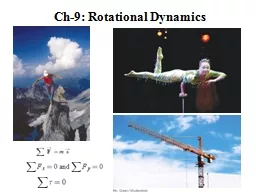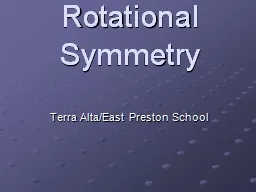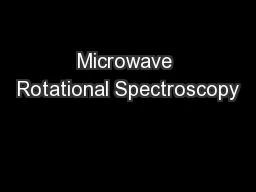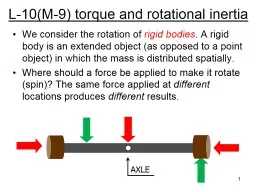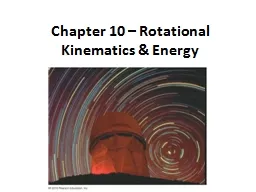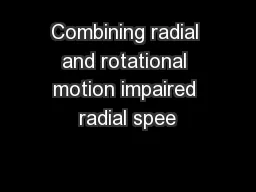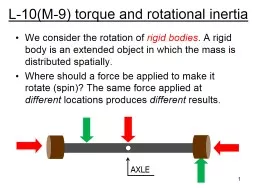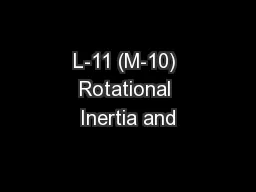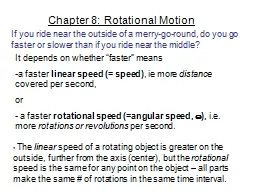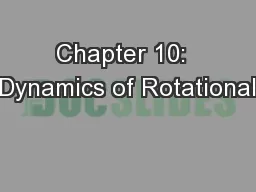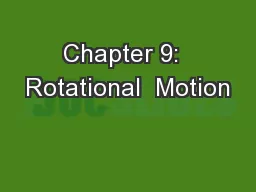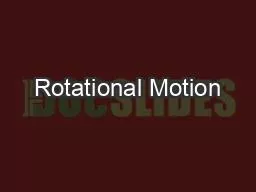PPT-Ch-9: Rotational Dynamics
Author : faustina-dinatale | Published Date : 2019-06-20
Translational and Rotational Motion Torque Which one of the above application of force F is the easiest to open a door Definition of Torque Torque is a vector
Presentation Embed Code
Download Presentation
Download Presentation The PPT/PDF document "Ch-9: Rotational Dynamics" is the property of its rightful owner. Permission is granted to download and print the materials on this website for personal, non-commercial use only, and to display it on your personal computer provided you do not modify the materials and that you retain all copyright notices contained in the materials. By downloading content from our website, you accept the terms of this agreement.
Ch-9: Rotational Dynamics: Transcript
Translational and Rotational Motion Torque Which one of the above application of force F is the easiest to open a door Definition of Torque Torque is a vector quantity Direction. Raymond S. . Troy, Robert V. Tompson, Jr., Tushar K. Ghosh and. Sudarshan . K.. Loylalka. Particulate Systems Research Center & Nuclear Science and Engineering Institute, University of Missouri, Columbia, MO 65211. Terra Alta/East Preston School. Rotational Symmetry. If, when you rotate a shape, it looks exactly the same as it did in its original position, then we say that the shape has . rotational symmetry. .. CHE 6416. Michael Evans. 1. How does Microwave relate to other spectroscopies. Different types of motion. Translational. Vibrational. Rotational.. 2. What is Microwave Spectroscopy?. Microwave stimulates Rotational translations. We consider the rotation of . rigid bodies. . A rigid body is an extended object (as opposed to a point object) in which the mass is distributed spatially.. Where should a force be applied to make it . Andy Pon, . Doug . Johnstone. ,. Michael J. Kaufman. ApJ. , submitted May 2011 . Ridge et al. (2006). Observed. (FWHM = 1.9 km / . s. ). Thermal broadening alone. (FWHM = 0.2 km / . s. ). 12. CO J = 1-0. 10.1 – Angular Position (. θ. ). In linear (or translational) kinematics we looked at the position of an object (. Δx. , . Δy. , . Δd. …). We started at a reference point position (x. i. ) and our definition of position relied on how far away from that position we are.. The results from our plaid stimuli extend those from prior random-dot studies that also showed distinctions . between . these MST-mediated (. radial versus rotational) motion judgments [4-9]. . Future experiments are needed to determine whether the present task effects reflect local speed differences, which can influence radial and rotational speed judgments [10-13].. Physics 1, NTC. Angular Motion, General Notes. When a rigid object rotates about a fixed axis in a given time interval, every portion on the object rotates through the same angle in a given time interval and has the same angular speed and the same angular acceleration.. and rotational inertia. We consider the rotation of . rigid bodies. . A rigid body is an extended object in which the mass is distributed spatially.. Where should a force be applied to make it rotate (spin)? The same force applied at . Conservation of rotational momentum. 1. Why does a wheel keep spinning. ?. Spinning ice skater . Video. . Why is a bicycle stable when it is moving, but falls over when it stops. ?. Why is it difficult to change the orientation of the axis of a spinning wheel?. If you ride near the outside of a merry-go-round, do you go faster or slower than if you ride near the middle?. It depends on whether “faster” means . a faster . linear speed (= speed). , ie more . Motion. © 2016 Pearson Education, Inc.. Dynamics of Rotational Motion. (Conservation of angular momentum). Goals for Chapter 10. Torque: “angular force”. To see how torques cause rotational dynamics (just as linear forces cause linear accelerations). © 2016 Pearson Education, Inc.. Goals for Chapter 9 . To study angular velocity and angular acceleration.. To examine rotation with constant angular acceleration.. To understand the relationship between linear and angular quantities.. Physics CNameANSWER KEYAP Review PacketLinear and angular analogsLinearRotationx positionx displacementvvelocityaTtangential accelerationVectors in rotational motionUse the right hand rule to determin
Download Rules Of Document
"Ch-9: Rotational Dynamics"The content belongs to its owner. You may download and print it for personal use, without modification, and keep all copyright notices. By downloading, you agree to these terms.
Related Documents

